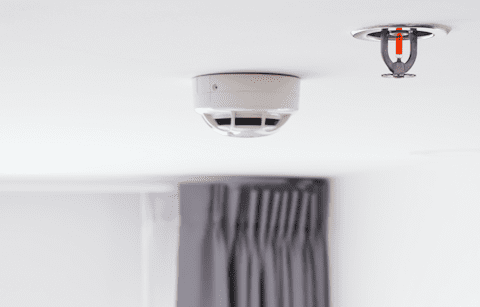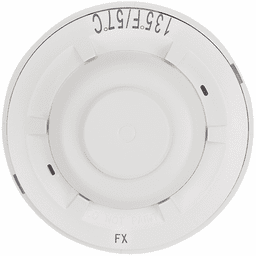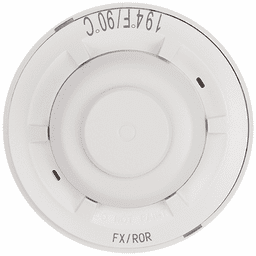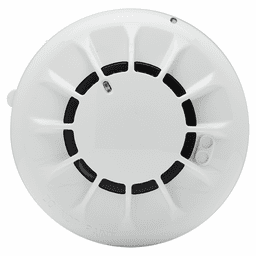Heat Detectors - GeoArm Security®
Heat Sensing
Early Emergency Warning!
A heat detector is a type of fire alarm device that detects heat or a significant rise in temperature in a specific area and to triggers an alarm system when a predetermined temperature or temperature rise is reached. Heat detectors can save lives by detecting high temperatures or fire in a building and alerting occupants to evacuate before it's too late. This early warning can give people more time to escape from the building and prevent injuries or fatalities. Heat detectors are an important part of any fire safety system, along with smoke detectors and sprinklers.
Typically, heat detectors are used in commercial and industrial properties such as factories, warehouses, manufacturing plants, restaurants, hospitals, hotels, museums, and other similar facilities. They are also used in residential properties such as homes, apartment complexes, and senior living facilities. In the event of a heat alarm, the GeoArm central monitoring station will perform appropriate action.

Common Uses for Heat Detectors?
1. Kitchens - In commercial and residential kitchens, where smoke from cooking might cause false alarms with smoke detectors, heat detectors are a better choice.
2. Garages - In garages, where exhaust fumes and dust can interfere with smoke detectors, heat detectors provide a more reliable option.
3. Boiler Rooms - These areas can have high ambient temperatures and steam, making heat detectors more effective than smoke detectors.
4. Attics and Crawl Spaces - These spaces can have varying temperatures and dust, which can affect smoke detectors, so heat detectors are often used.
5. Industrial Environments - In factories or warehouses where dust, smoke, or vapors are present, heat detectors are preferred to avoid false alarms.
Installation Tips for Heat Detectors?
1. Location Selection - Install heat detectors in areas where smoke detectors might not be suitable, such as kitchens, garages, or dusty environments. Avoid placing them near air vents, fans, or areas with high humidity.
2. Height and Placement - Mount heat detectors on the ceiling or high on the wall, as heat rises. Ensure they are at least 4 inches away from the wall if mounted on the ceiling, and 4 to 12 inches from the ceiling if mounted on the wall.
3. Spacing - Follow the manufacturer's guidelines for spacing between detectors. Generally, they should be placed no more than 50 feet apart in a standard room, but this can vary based on the specific model and room conditions.
4. Compatibility - If wireless, ensure the wireless heat detector is compatible with your existing fire alarm system or smart home setup.
5. Battery Life - Use high-quality batteries and check them regularly. Many wireless detectors have a low-battery alert, but it's good practice to replace batteries annually.
6. Signal Strength - Check the wireless signal strength between the detector and the control panel. Ensure there are no large metal objects or thick walls that could interfere with the signal.
7. Wiring and Power Supply - If wired, ensure the detectors are properly wired and connected to a reliable power source. If they are battery-operated, regularly check and replace the batteries as needed.
8. Testing - After installation, test the heat detectors to ensure they are functioning correctly. Regular testing should be part of your maintenance routine.
9. Compliance - Make sure the installation complies with local building codes and fire safety regulations. Consult with a professional if you're unsure about any requirements.
10. Environmental Considerations - Avoid installing heat detectors in areas with extreme temperatures or where they might be exposed to direct sunlight, as this can affect their performance.
Types of Heat Detectors?
1. Fixed Temperature Heat Detectors - These detectors activate when the temperature reaches a predetermined point. They are reliable and commonly used in areas where rapid temperature changes are unlikely. Heat detectors are often used in areas where smoke detectors may not work well, such as in dusty or humid environments, or where smoke may not be present in the early stages of a fire.
2. Rate-of-Rise Heat Detectors - These detectors respond to a rapid increase in temperature, typically around 12 to 15 degrees Fahrenheit per minute. They are useful in environments where a sudden rise in temperature is a strong indicator of a fire.

Companies
 Month-to-Month Subscription Plans
Month-to-Month Subscription Plans Takeover a Wide Range of Control Panels
Takeover a Wide Range of Control Panels Choose from Non-Proprietary Equipment
Choose from Non-Proprietary Equipment Optional 24/7 Professional Central Station
Optional 24/7 Professional Central Station More Flexible DIY Brands and Services
More Flexible DIY Brands and Services Nationwide Coverage is Supported
Nationwide Coverage is Supported Inexpensive Remote Technicians
Inexpensive Remote Technicians


























